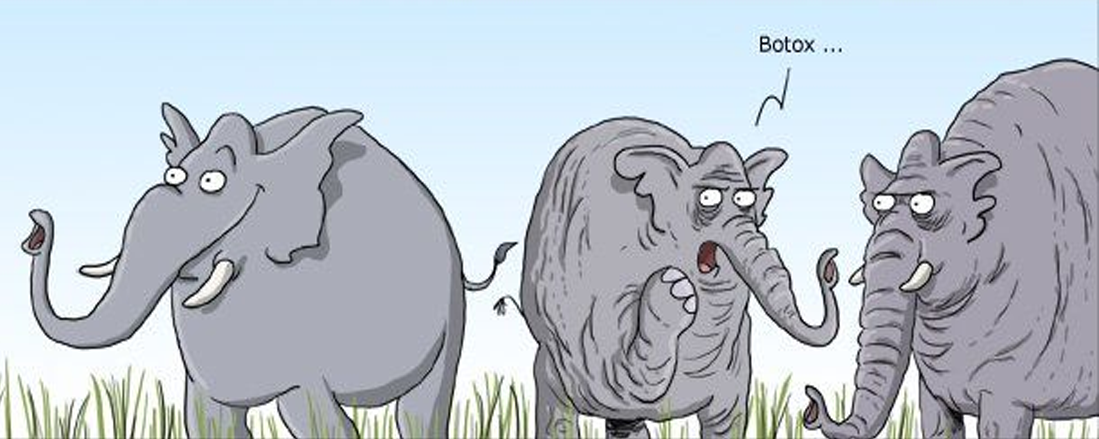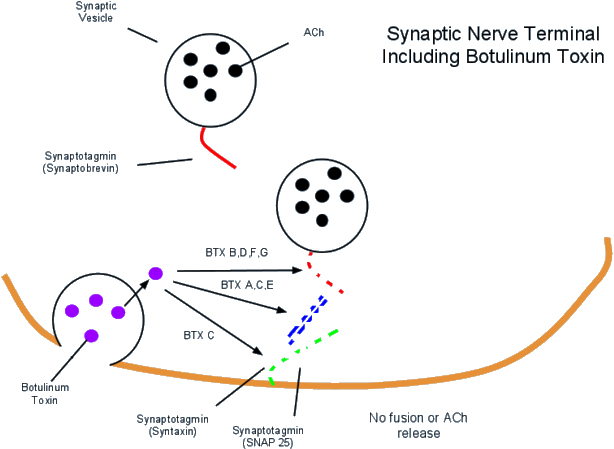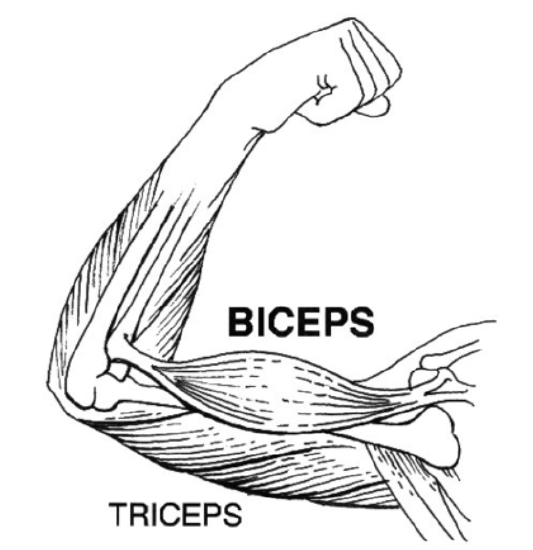15.7: Case Study Conclusion: Needing to Relax and Chapter Summary
- Last updated
- Save as PDF
- Page ID
- 22559
Case Study Conclusion: Needing to Relax
As you learned at the beginning of this chapter, botulinum toxin—one form sold under the brand name Botox—does much more than smooth out wrinkles. It can be used to treat several disorders involving excessive muscle contraction, including cervical dystonia. You also learned that cervical dystonia, from which Nasir suffers, causes abnormal, involuntary muscle contractions of the neck. This results in the head and neck's jerky movements and/or a sustained abnormal tilt to the head. It is often painful and can significantly interfere with a person’s life.

How could a toxin actually help treat a muscular disorder? The soil bacterium Clostridium botulinum produces the botulinum toxin, and it is the cause of the potentially deadly disease called botulism. Botulism is often a foodborne illness, commonly caused by improperly canned foods. Other forms of botulism are caused by wound infections or occur when infants consume the bacteria's spores from soil or honey.
Botulism can be life-threatening because it paralyzes muscles throughout the body, including those involved in breathing. When a minimal amount of botulinum toxin is injected carefully into specific muscles by a trained medical professional, however, it can inhibit unwanted muscle contractions.

For cosmetic purposes, botulinum toxin injected into the facial muscles relaxes them to reduce wrinkles' appearance. When used to treat cervical dystonia, it is injected into the neck muscles to inhibit excessive muscle contractions. For many patients, this helps relieve the abnormal positioning, movements, and pain associated with the disorder. The effect is temporary, so the injections must be repeated every three to four months to keep the symptoms under control.
How does botulinum toxin inhibit muscle contraction? First, recall how skeletal muscle contraction works. A motor neuron instructs skeletal muscle fibers to contract at a synapse between them called the neuromuscular junction. A nerve impulse called an action potential travels down to the motor neuron's axon terminal, where it causes the release of the neurotransmitter acetylcholine (ACh) from synaptic vesicles. The ACh travels across the synaptic cleft and binds to ACh receptors on the muscle fiber, signaling the muscle fiber to contract. According to the sliding filament theory, muscle fibers' contraction occurs due to the sliding of myosin and actin filaments across each other. This causes the Z discs of the sarcomeres to close together, shortening the sarcomeres and causing the muscle fiber to contract.

If you wanted to inhibit muscle contraction, at what points could you theoretically interfere with this process? Inhibiting the action potential in the motor neuron, the release of ACh, the activity of ACh receptors, or the sliding filament process in the muscle fiber would all theoretically impair this process and inhibit muscle contraction. For example, in the disease myasthenia gravis, the ACh receptors' function is impaired, causing a lack of sufficient muscle contraction. As you have learned, this results in muscle weakness that can eventually become life-threatening. Botulinum toxin works by inhibiting the release of ACh from the motor neurons, thereby removing the signal instructing the muscles to contract (Figure \(\PageIndex{3}\)).
Fortunately, Nasir’s excessive muscle contractions and associated pain improved significantly, thanks to botulinum toxin injections. Although cervical dystonia cannot currently be cured, botulinum toxin injections have improved many patients' quality of life with this and other disorders involving excessive involuntary muscle contractions.
As you have learned in this chapter, our muscular system allows us to make voluntary movements, digest our food, and pump blood through our bodies. Whether in your arm, heart, stomach, or blood vessels, muscle tissue works by contracting. But as you have seen here, too much contraction can be a terrible thing. Fortunately, scientists and physicians have found a way to put a potentially deadly toxin—and wrinkle-reducing treatment—to excellent use as a medical treatment for some muscular system disorders.
Chapter Summary
In this chapter, you learned about the muscular system. Specifically, you learned that:
- The muscular system consists of all the muscles of the body. There are three types of muscle: skeletal muscle (which is attached to bones by tendons and enables voluntary body movements), cardiac muscle (which makes up the walls of the heart and makes it beat), and smooth muscle (which is found in the walls of internal organs and other internal structures and controls their movements).
- Muscles are organs composed mainly of muscle cells, which may also be called muscle fibers or myocytes. Muscle cells are specialized for contracting, which occurs when protein filaments inside the cells slide over one another using energy from ATP. Muscle tissue is the only type of tissue that has cells with the ability to contract.
- Muscles can grow larger or hypertrophy. This generally occurs through increased use, although hormonal or other influences can also play a role. Muscles can also grow smaller or atrophy. This may occur through lack of use, starvation, certain diseases, or aging. In both hypertrophy and atrophy, the size—but not the number—of muscle fibers changes. The size of the muscles is the main determinant of muscle strength.
- Skeletal muscles need the stimulus of motor neurons to contract and to move the body; they need the skeletal system to act upon.
- Skeletal muscle is the most common type of muscle tissue in the human body. To move bones in opposite directions, skeletal muscles often consist of pairs of muscles that work in opposition to move bones in different directions at joints.
- Skeletal muscle fibers are bundled together in muscle fascicles, which are bundled together to form individual skeletal muscles. Skeletal muscles also have connective tissue supporting and protecting the muscle tissue.
- Each skeletal muscle fiber consists of a bundle of myofibrils, which are bundles of protein filaments. The filaments are arranged in repeating units called sarcomeres, which are the skeletal muscles' basic functional units. Skeletal muscle tissue is striated because of the pattern of sarcomeres in its fibers.
- Skeletal muscle fibers can be divided into two types, called slow-twitch and fast-twitch fibers. Slow-twitch fibers are used mainly in aerobic endurance activities (such as long-distance running). Fast-twitch fibers are used mainly for non-aerobic, strenuous activities (such as sprinting). Proportions of the two types of fibers vary from muscle to muscle and person to person.
- Smooth muscle tissue is found in the walls of internal organs and vessels. When smooth muscles contract, they help the organs and vessels carry out their functions. Contractions of smooth muscles are involuntary and controlled by the autonomic nervous system, hormones, and other substances.
- Cells of smooth muscle tissue are not striated because they lack sarcomeres, but the cells contract in the same basic way as striated muscle cells. Unlike striated muscle, smooth muscle can sustain very long-term contractions and maintain its contractile function, even when stretched.
- Cardiac muscle tissue is found only in the wall of the heart. When cardiac muscle contracts, the heart beats and pumps blood. Contractions of cardiac muscle are involuntary, like those of smooth muscles. Electrical impulses from specialized cardiac cells control them.
- Like skeletal muscle, cardiac muscle is striated because its filaments are arranged in sarcomeres. However, the exact arrangement differs, making cardiac and skeletal muscle tissues look different from one another.
- The heart is the muscle that performs the greatest amount of physical work in a lifetime. Its cells contain many mitochondria to produce ATP for energy and help the heart resist fatigue.
- A muscle contraction is an increase in tension or a decrease in the length of a muscle. A muscle contraction is isometric if muscle tension changes, but muscle length remains the same. It is isotonic if muscle length changes, but muscle tension remains the same.
- A skeletal muscle contraction begins with the electrochemical stimulation of a muscle fiber by a motor neuron. This occurs at a chemical synapse called a neuromuscular junction. The neurotransmitter acetylcholine diffuses across the synaptic cleft and binds to receptors on the muscle fiber. This initiates a muscle contraction.
- Once stimulated, the skeletal muscle fibers' protein filaments slide past each other to produce a contraction. The sliding filament theory is the most widely accepted explanation for how this occurs. According to this theory, thick myosin filaments repeatedly attach to and pull on thin actin filaments, thus shortening sarcomeres.
- Crossbridge cycling is a cycle of molecular events that underlies the sliding filament theory. Using energy in ATP, myosin heads repeatedly bind with and pull on actin filaments. This moves the actin filaments toward the center of a sarcomere, shortening the sarcomere and causing a muscle contraction.
- The ATP needed for a muscle contraction comes first from ATP already available in the cell, and more is generated from creatine phosphate. These sources are quickly used up. Glucose and glycogen can be broken down to form ATP and pyruvate. Pyruvate can then be used to produce ATP in aerobic respiration if oxygen is available or used in anaerobic respiration if oxygen is not available.
- Physical exercise is defined as any bodily activity that enhances or maintains physical fitness and overall health. Activities such as household chores may even count as physical exercise! Current recommendations for adults are 30 minutes of moderate exercise a day.
- Aerobic exercise is any physical activity that uses muscles at less than their maximum contraction strength but for long periods of time. This type of exercise uses a relatively high percentage of slow-twitch muscle fibers that consume large amounts of oxygen. Aerobic exercises increase cardiovascular endurance and include cycling and brisk walking.
- Anaerobic exercise is any physical activity that uses muscles at close to their maximum contraction strength, but for short periods of time. This type of exercise uses a relatively high percentage of fast-twitch muscle fibers that consume small amounts of oxygen. Anaerobic exercises increase muscle and bone mass and strength, and they include push-ups and sprinting.
- Flexibility exercise is any physical activity that stretches and lengthens muscles, thereby improving the range of motion and reducing injury risk. Examples include stretching and yoga.
- Many studies have shown that physical exercise is positively correlated with a diversity of physical, mental, and emotional health benefits. Physical exercise also increases the quality of life and life expectancy.
- Many of the exercise benefits may come about because contracting muscles release hormones called myokines, which promote tissue repair and growth and have anti-inflammatory effects.
- Physical exercise can reduce risk factors for cardiovascular disease, including hypertension and excess body weight. Physical exercise can also increase cardiovascular health factors, such as the mechanical efficiency of the heart.
- Physical exercise has been shown to offer protection from dementia and other cognitive problems, perhaps because it increases blood flow or neurotransmitters in the brain, among other potential effects.
- Numerous studies suggest that regular aerobic exercise works and pharmaceutical antidepressants in treating mild-to-moderate depression, possibly because it increases the synthesis of natural euphoriants in the brain.
- Research shows that physical exercise generally improves sleep for most people and helps sleep disorders, such as insomnia. Other health benefits of physical exercise include better immune system function and reduced risk of type 2 diabetes and obesity.
- There is great variation in individual responses to exercise, partly due to genetic differences in proportions of slow-twitch and fast-twitch muscle fibers. People with more slow-twitch fibers may be able to develop greater endurance from aerobic exercise. In contrast, people with more fast-twitch fibers may develop greater muscle size and strength from anaerobic exercise.
- Some adverse effects may occur if exercise is extremely intense, and the body is not given proper rest between exercise sessions. Many people who overwork their muscles develop delayed onset muscle soreness (DOMS), caused by tiny tears in muscle fibers.
- Musculoskeletal disorders are injuries in muscles or associated tissues (such as tendons) because of biomechanical stresses. The disorders may be caused by sudden exertion, over-exertion, repetitive motions, and similar stresses.
- A muscle strain is an injury in which muscle fibers tear as a result of overstretching. First aid for a muscle strain includes the five steps represented by the acronym PRICE (protection, rest, ice, compression, and elevation). Medications for inflammation and pain (such as NSAIDs) may also be used.
- Tendinitis is inflammation of a tendon that occurs when it is over-extended or worked too hard without rest. Tendinitis may also be treated with PRICE and NSAIDs.
- Carpal tunnel syndrome is a biomechanical problem in the wrist when the median nerve becomes compressed between carpal bones. It may occur with repetitive use, a tumor, or trauma to the wrist. It may cause pain, numbness, and eventually—if untreated—muscle wasting in the thumb and first two fingers of the hand.
- Neuromuscular disorders are systemic disorders that occur because of problems with the nervous control of muscle contractions or muscle cells themselves.
- Muscular dystrophy is a genetic disorder caused by defective proteins in muscle cells. It is characterized by progressive skeletal muscle weakness and death of muscle tissues.
- Myasthenia gravis is a genetic neuromuscular disorder characterized by fluctuating muscle weakness and fatigue. More muscles are affected, and muscles become increasingly weakened, as the disorder progresses. Myasthenia gravis most often occurs because immune system antibodies block acetylcholine receptors on muscle cells because of the actual loss of acetylcholine receptors.
- Parkinson’s disease is a degenerative disorder of the central nervous system that mainly affects the muscular system and movement. It occurs because of the death of neurons in the midbrain. Characteristic signs of the disorder are muscle tremor, muscle rigidity, slowness of movement, and postural instability. Dementia and depression also often characterize advanced stages of the disease.
As you saw in this chapter, muscles need oxygen to provide enough ATP for most of their activities. In fact, all of the body’s systems require oxygen and remove waste products, such as carbon dioxide. In the next chapter, you will learn about how the respiratory system obtains and distributes oxygen throughout the body and how it removes wastes, such as carbon dioxide.
Chapter Summary Review
- True or False. Each motor neuron controls one muscle fiber.
- True or False. Peristalsis is a pattern of muscle contraction in smooth muscle tissue.
- When muscles atrophy:
- muscle fibers become narrower
- muscle fibers turn into fat cells
- muscle fibers are lost
- muscle fibers become shorter
- What are tendons?
- What is a muscular system disorder involving tendons?
- Which of the main types of muscle tissue is used when you make a voluntary movement of one of your limbs?
- Which main types of muscle tissue function independently of conscious control by the brain?
- Describe the relationship between muscles, muscle fibers, and fascicles.
- Choose one. The (autonomic; somatic) nervous system controls the skeletal muscles.
- True or False. Sarcomeres are the cells of the muscular system.
- True or False. Muscles contain connective tissue as well as muscle tissue.
- The biceps and triceps muscles are shown in Figure \(\PageIndex{4}\). Answer the following questions about these arm muscles.
- When the biceps contract and become shorter, as in the illustration, what kind of motion does this produce in the arm?
- Is the situation described in part more likely to be an isometric or isotonic contraction? Explain your answer.
- If the triceps were to then contract, which way would help the arm move?

Figure \(\PageIndex{4}\): biceps
- Put the following events in order of when they occur during the process of skeletal muscle contraction, from earliest to latest:
- Acetylcholine binds to receptors on the muscle fiber
- Actin filaments slide, shortening the sarcomere
- An action potential is initiated in a motor neuron
- Acetylcholine is released from synaptic vesicles
- What are Z discs, and what happens to them during muscle contraction?
- True or False. Synapses only exist between neurons.
- True or False. Muscles can produce hormones.
- Which have been called the strongest muscles in the human body, relative to their work?
- The heart muscles
- The hamstring muscles
- The external eye muscles
- The stomach muscles
- What is the function of mitochondria in muscle cells? Which type of muscle fiber has more mitochondria—slow-twitch or fast-twitch?
- Fast-twitch and slow-twitch are types of which kind of muscle fibers?
- skeletal
- smooth
- cardiac
- B and C
- Myoglobin:
- Stores oxygen for anaerobic respiration
- Stores oxygen for aerobic respiration
- Is present in higher amounts in fast-twitch fibers than slow-twitch fibers
- Is where ATP is produced
- True or False. All people have the same proportion of slow-twitch to fast-twitch muscle fibers.
- True or False. A sprain is a tear in the muscle fibers.
- Which condition directly damages neurons, not muscles?
- Myasthenia gravis
- Muscular dystrophy
- Musculoskeletal disorder
- Parkinson’s disease
- What is the difference between primary and secondary Parkinson’s disease?
- Why can carpal tunnel syndrome cause muscle weakness in the hands?
- True or False. The heart consists of smooth muscle tissue.
- True or False. Sprinting is considered an anaerobic exercise
Attribution
- Botox comic by Michael Reuter, CC BY 2.0 via Flickr
- Botulism by Jason Wilson, CC BY 2.0 via Flickr
- Botulinum Toxin Mechanism by Rysin, public domain via Wikimedia Commons
- Biceps by Pearson Scott Foresman, public domain via Wikimedia Commons
- Text adapted from Human Biology by CK-12 licensed CC BY-NC 3.0


